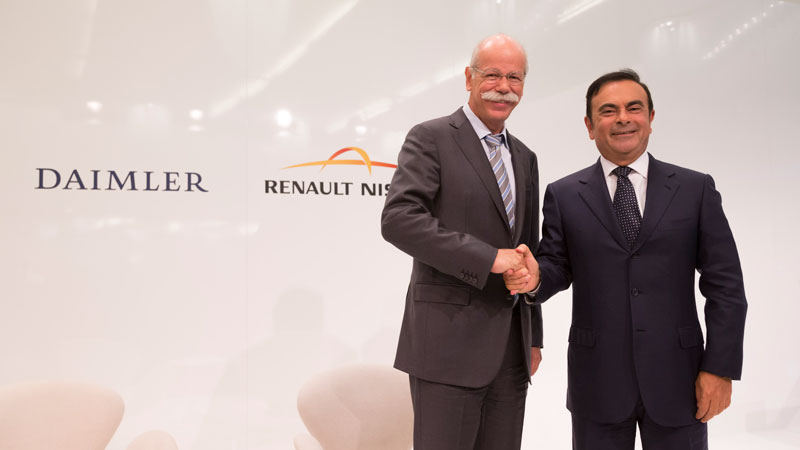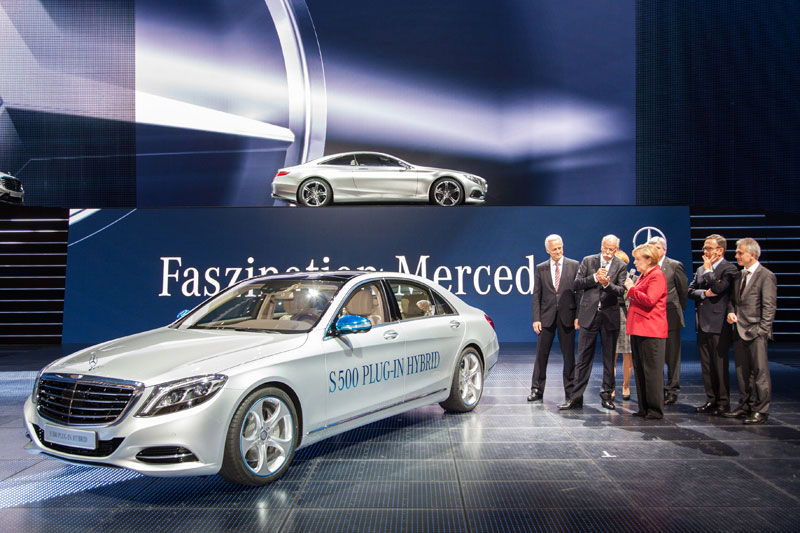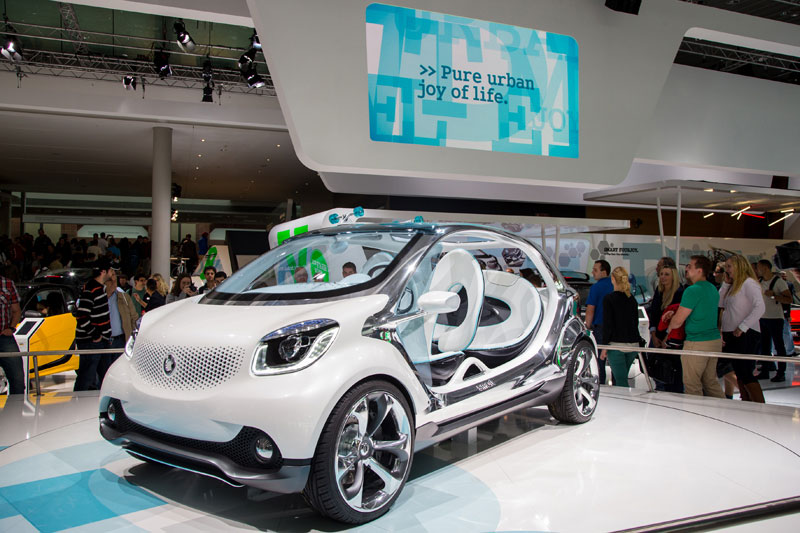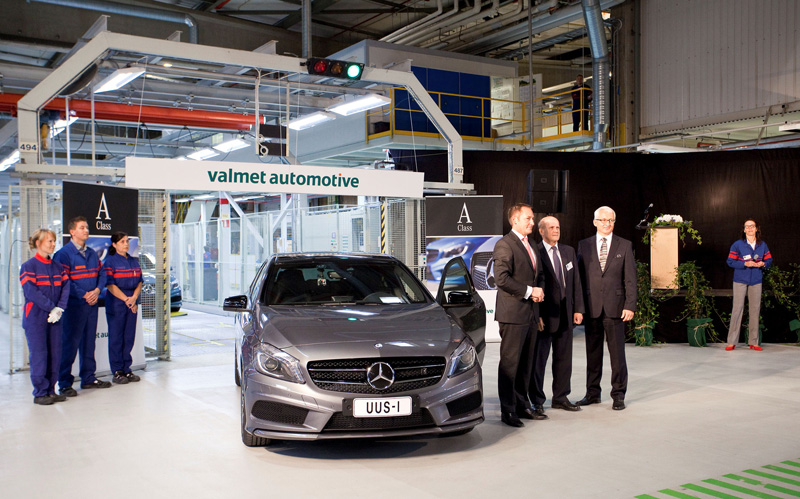Mercedes-Benz is in the midst of a major product offensive. Four of the five models in its compact range have been launched; the news S-Class followed the launch of the E-Class, and at the 2014 Detroit auto show, Mercedes-Benz will unveil the next-generation C-Class.
Daimler’s Q3 results showed a 13% year-on-year increase in vehicle sales, to 595,000 vehicles, with car sales up by 14% to 395,400 units. Net profit rose by 53% year-on-year to €1,897m, and the OEM is bullish on Q4 performance, when it says growth will continue in unit sales and revenue, resulting in full year totals over 2012 totals.
At the 2013 Frankfurt motor show (IAA), Dr. Dieter Zetsche, Chairman of Daimler’s Board of Management and Head of Mercedes-Benz Cars, discussed some of the factors behind the company’s current performance, and the key issues which face the Mercedes-Benz car brand in particular.

Strategic partnerships
The strategic partnership with the Renault-Nissan Alliance has been facilitated by the close relationship between Zetsche and Renault-Nissan’s Carlos Ghosn. “In very general terms, we have seen positive development since the very beginning,” said Zetsche. “We are making progress in the different areas we’re working on together.”
At the IAA, Nissan’s Infiniti unveiled the Q30 concept, the brand’s first compact crossover. In mid-October, a groundbreaking ceremony at Nissan’s Sunderland, UK factory marked construction of the additional manufacturing facilities required to produce Infiniti’s first European-built car. The Q30 will go into production from 2015, based on Daimler’s MFA platform. MFA stands for Modular Front Architecture, the Mercedes-Benz compact car platform which underpins A/B-, CLA- and GLA-Class models.
“We have a strategic co-operation with Renault and Nissan and we have a number of areas where we leverage that. Compact cars is one area where we’re looking at opportunities. We are not calculating every specific product in a give-and-take kind of balance sheet, but we want the overall co-operation to be a balanced one. We are developing a very strong position on the compact car side, and some of that can benefit Nissan as well.”

Another strategic partner is Aston Martin. In July, the UK sports car manufacturer signed a Letter of Intent with Daimler’s high performance Mercedes-AMG brand. The engine technology exchange deal enables Aston Martin to tap Mercedes-AMG and Mercedes-Benz Cars’ resources for use in its own V8 powertrains, and gives it access to certain electric/electronic (e/e) architecture components.
However, Zetsche gave no indication of wishing to extend this arrangement. “The new investor in Aston Martin saw that Aston Martin needs a technical partner and asked us whether we would be willing to serve that role. There is no future takeover plan. We are not a collector of brands. But we appreciate this co-operation because we do see a very strong brand and think that it can become even stronger based on co-operation on technology.”
As for the possibility of additional projects developing, “You never should say no. Let’s see how and where that goes. But, once again, there is no plan of changing the autonomy of this company.”

Volume versus premium
Since the introduction of the C-Class, Mercedes-Benz has walked the line between volume and premium; the manufacturer is currently pushing its new S-Class at one end of the scale and its compact car range at the other end. The Mercedes-Benz range of compact cars – there will eventually be five based on the A and B-Class – has grown by almost 70% in 2013. Compacts account for around a quarter of Mercedes-Benz sales, and Zetsche expects that to grow beyond 30%. “It’s not particularly important to grow in compacts, but it is important to leverage the growth potential which exists in different segments,” he said, “and definitely the compact segment is a very big one. Therefore, the potential is big and we want to leverage that.”
Here, the need to find a balance between premium products and economies of scale becomes clear: “It’s important for any company to be profitable and have a growth story; both combined it defines your share development. Secondly, when you strive to be the number one in an industry, typically that includes the many customers that come to the same conclusion by choosing your product. So this ultimately should lead to a leading market share position as well. Having said that, now you can only get there when you are successful in the different segments of your industry. And, as today there is definitely a premium sector within compact cars, we want to be successful there and we’re doing that right now in a very impressive way. We said there will be five.” At the IAA, Mercedes-Benz launched the fourth, the GLA. “One to come. Stay tuned.”

S express
The decision to use the S-Class to extend the Mercedes-Benz range into territory previously occupied by the Maybach models was both brave and bold, underlining the company’s absolute confidence in the strength of that model series, and in the Mercedes-Benz brand. However, it was also a risk, given that it bears the same three-pointed star as the A-Class. Could a strategy based on growth have an impact on the brand’s premium values?
“When we started with the first generation A and B-Class, we achieved the volumes we were shooting for but definitely they were not brand shapers,” he said. “They did not give any momentum, agility to the brand. Our job is, of course, to be in the lead on technology. But at the same time we want to build dreams, and definitely the original A and B-Class were solid cars but not dreams. The new ones are. Many people are striving for these. For some they’re still too expensive. But we get lots of young people coming to our show saying, ‘that’s the car I want to have, but the other guys are giving me 30% rebate and you don’t, so unfortunately I can’t go for your car’. That’s what we want to accomplish, and therefore we are definitely very, very satisfied with the development of our compacts, including the impact on our brand, because ultimately the S-Class buyer wants to be associated with a brand that is lively, attractive to younger people as well because, whatever their ages, every one of our S-Class buyers feels very young.”
And on that point, Zetsche is convinced that S-Class buyers are content that their buy-in to the Mercedes-Benz brand is shared with A-Class owners. “I am very sure. That might not be the answer of every single particular customer, but directionally, yes.”
“First of all, it’s obvious that the new S-Class is the car in that segment, and fortunately we get this feedback from many in the media. We said that we see a more promising future for Daimler in the top end of the market based on the Mercedes S-Class. So the foundation has been proven and now we’ll see the expansion, which goes beyond the former scope of the S-Class and addresses a number of customers and prospects in this top segment. We’re not talking in the first place about this half-a-million-plus price bracket, but rather about the €200,000 plus price bracket.” But even at the very top end of the range, Zetsche said a Pullman-type version would be identifiable as a Mercedes-Benz, and even as an S-Class. “It definitely would be a Mercedes, and would look like a Mercedes, and, to a high extent, like an S-Class as well.”

From S-Class to small, smart cars
Back at the other end of the scale, at a time when small highly efficient cars are increasingly important for any OEM, smart may continue to sell well, but it is starting to look like a forgotten brand. At the IAA, smart showed a four-door concept, but Zetsche ruled out any chance of that concept going into series production: “There are no plans in that direction at this point in time. There are some limitations as well, based on the concept, which gives us the best space efficiency of any product, obviously important in metropolitan traffic. But the rear position of the engine limits the kind of body styles you can develop from that. So it’s the ideal urban vehicle and that’s what we want to be with smart, but not being limited to two seats.”
In previous interviews, Zetsche has hinted the he might be considering a car smaller than the A-Class. “We have made no decision to move into the B-segment. Certainly there is some volume opportunity. On the other hand, it’s very tough to be profitable in this segment. So far we don’t see a need to go there, but this might not be the final answer.”
Regional market performance
Mercedes-Benz has been one of the few brands to enjoy growth despite the difficult market conditions in Europe. Looking beyond 2013, Zetsche said he believes the worst is over: “We do believe that the recession has bottomed out and we will start to see some growth, including the car markets.” Zetsche was keen to follow his assessment of the market with a comment always like to drop into interviews about the fact that Mercedes-Benz continues to experience under-capacity rather than overcapacity. “Even with more demand in Europe, we couldn’t sell more. But that is not something you can base your future plans on. We need some better market conditions in the long run, of course, as well.” Despite his optimism, he emphasised that recovery will be slow and long-lasting, rather than steep. In the US, Zetsche said Mercedes-Benz is “growing at or beyond market pace, leading the premium manufacturers.” In China, where Mercedes-Benz has struggled and, as a result, restructured its sales organisation, Zetsche expects Mercedes-Benz to grow faster than in the US. “We will continue to improve our relative position in China. Many of the prerequisites have been set, so that’s our homework we have to do and where we are making progress.” To that end, Daimler has recruited Duan Jianjun as the new Head of Sales and Marketing of Beijing Mercedes-Benz Sales Service Company (BMBS). Jianjun, who joined BMBS on 1 November, was previously Sales Director at BMW Brilliance.

Production ‘under-capacity’
The need for additional manufacturing capacity has seen Daimler outsource some production to contract manufacturer Valmet in Finland, which began building the A-Class in September. “Except for the C-Class, where we are approaching the [model] changeover, we are basically short on all our model lines. We see expansion in China, which we are realising right now. We have the capacity in Valmet just coming on stream. That is up to 60,000 units a year. But we are looking beyond that. We have an expansion in Tuscaloosa which is still not used, but will be used for the C-Class next year, in the range of 70 to 80,000 units. So within these limitations, we’re expanding everywhere but we need more plants as well. These will not be in Germany but basically where the additional demand is coming from.”
Since this interview, Daimler has confirmed plans to invest in a Greenfield plant in Brazil. The reasoning behind this is clear: “You know that we want to be on par or ahead of our direct competitors by the end of the decade, and this requires the best products and great sales but the capacity as well. That means we have to grow to the same levels, and they will continue to grow as well. Of course, the capacity follows the demand, and that’s where we are defining our plants.” An announcement is expected on a joint manufacturing activity with Infiniti in Mexico, but at the IAA Zetsche would not be drawn on this matter.
Outlook for 2013
Rounding off its Q3 2013 report, Daimler said the Mercedes-Benz Car division will reach a new record level of unit sales in 2013, thanks to numerous model changes and new products. Group revenue is expected to increase again in 2013, it said, with the main source of revenue growth coming from “the successful product offensive of Mercedes-Benz Cars”.
Martin Kahl
